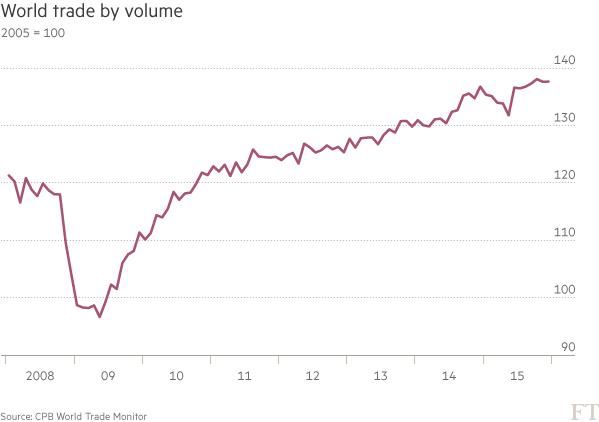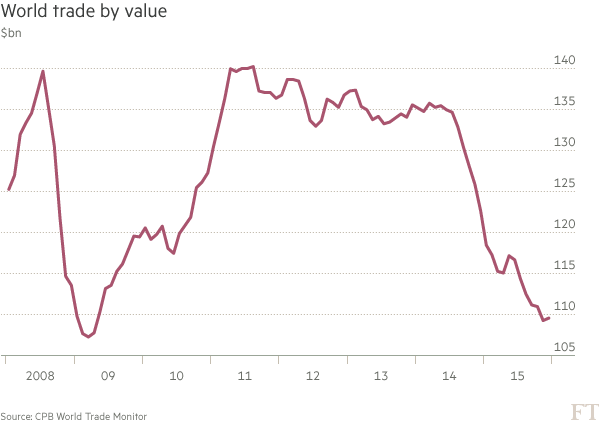Chicago Business Barometer Reverses Earlier Improvement
The Chicago Purchasing Managers indicated that its General Business Barometer retreated to 47.6 during February following a surge to 55.6 in January. The reading remained at the low end of the range during the last year. The ISM-Adjusted index fell to 46.7 and gave back its January improvement. During the last ten years, there has been a 62% correlation between the index level and quarterly growth in real GDP.
Declines in the production and the new orders series were pronounced. Employment also fell sharply to the lowest level since November 2009. Fourteen percent (NSA) of respondents reported higher job levels while 24% reported declines. Order backlogs also fell, but supplier deliveries and inventories series rose slightly.
From Doug Short:
(…) The reading gained m/m due to the production figure, but new orders growth remained depressed. (…)
U.S. Pending Home Sales Tumbled 2.5% in January The number of existing homes tentatively sold across the U.S. fell 2.5% in January, as swiftly rising prices and lower inventory muted buyer demand.
(…) In 2015, the index averaged 108.9, a rise of 8.0% over 2014 and its highest level since 2006. (…)
Pending home sales rose 1.4% in January from a year earlier, the 17th straight month the index has increased year over year, but that was its second-smallest annual gain over that period.
Several economists noted January’s blizzard may have dampened activity in the Northeast, but the index fell most in the Midwest and Northwest, declining by 4.9% and 4.5% respectively. (…)
Last 3 months annualized:
- Total: -2.0%
- Northeast: +6.1%
- Midwest: -15.2%
- South: +6.1%
- West: -43.4%
If this does not convince you that real estate is primarily local and not national… BTW, the West’s –43.5% is not a typo!
Like it or not, the housing sector seems at its cyclical high if one considers 2004-05 as an aberration. Only the new house series remain cyclically depressed but for their on particular reasons. New housing is but 10% of total housing. 9Chart from Doug Short)

Fed’s Dudley: Risks to Economy May Be Tilting ‘Slightly’ to Downside
(…) Should the turmoil in markets persist, it would trigger a “more significant downgrade” to his outlook, Mr Dudley said, according to prepared remarks to be delivered on a trip to China. He said a further fall in market and survey-based inflation expectations would be “worrisome”, as doggedly low inflation could eventually become entrenched in investors and consumers’ outlooks.(…)
RECESSION WATCH
This generally minor indicator has gained in importance given its amazing strength amid a generally slow consumer sector. It had dropped precipitously in recent months but bounced back into positive territory in January (from CalculatedRisk)
China Sweetens Home-Ownership Deals for Rural Dwellers Local governments in more than 100 Chinese cities have accelerated efforts to encourage rural dwellers to buy urban homes, hoping to resolve the country’s potentially crippling housing glut.
(…) Score one for the government’s effort to resolve China’s potentially crippling housing glut partly by encouraging rural dwellers to buy urban homes. In recent months, local governments in more than 100 cities have accelerated efforts to do this by loosening measures such as tax cuts, widened quotas for government-subsidized housing loans and cash subsidies.
These and other measures are targeting an oversupply of homes—apart from the top-tier cities such as Beijing, Shanghai and Shenzhen—that has been a drag on the world’s second-largest economy. While housing sales rose 6.9% by volume in 2015, China’s inventory of completed homes reached an all-time high at 452.5 million square meters (4.9 million square feet) as of the end of 2015, up 11.2% from 2014. This doesn’t include numerous homes currently under construction.
The overbuilding has weakened investment appetite and led to a fall in housing starts for a second straight year. Related industries such as steel, furniture, transport and machinery are also facing dwindling prospects.
Analysts and housing officials estimate that it would take around two years to digest supply in hundreds of smaller cities, with the most severe cases of overbuilding in China’s northeast rust belt. (…)
U.S. Shale Producers Cut Back Production Amid Global Glut Some of America’s biggest shale producers are beginning to ratchet back oil and gas production for the first time in years, bending to the reality that a global glut will keep prices depressed.
(…) So after years of boosting oil and gas flows across Oklahoma, Texas and North Dakota, Continental Resources Inc., Devon Energy Corp. and Marathon Oil Corp. say they plan to pull roughly 10% less from the ground in 2016 than they did last year. EOG Resources Inc. joined the chorus Friday, telling investors it has curbed production and expects to pump 5% less oil this year. (…)
EOG, which lost money last year for the first time, is considered by many analysts to be the most efficient shale operator in the U.S. Chief Executive Bill Thomas said the company would only pump wells that give it a high rate of return—at least 30%—when U.S. crude sells for $40 a barrel. (…)
More than three dozen energy companies have collectively gutted their budgets by nearly 50% on average in recent weeks, dialing back spending for the year by roughly $36 billion when compared with 2015. (…)
IHS, the consulting firm that held the energy gathering in Houston last week, is forecasting that U.S. oil output could fall from more than 9 million barrels a day to as little as 8.3 million barrels a day by this summer.
If that drop does materialize, it could boost crude prices back to the $40-a-barrel range, according to IHS.
One risk, though, is that as prices move higher, some producers may be tempted to turn on the spigot once again, a move that could in turn drive prices back down. (…)
If that happens, prices could collapse even below current levels, said Jamie Webster,senior director of oil markets for IHS. (…)
ExxonMobil in $12bn bond sale Issuance comes as oil major risks losing its triple A rating
(…) Last year the company made $30.3bn in cash from operations, which was almost enough to cover its capital spending, but it had to borrow to cover its dividend payments of about $12.1bn.
Net debt rose by more than $10bn, from $24.4bn at the end of 2014, to $35bn at the end of 2015.
Although Exxon has given up on share buybacks and cut its capital spending by a further 25 per cent to $23.2bn, its debts are still likely to rise again this year. (…)
When rating the bond sale, S&P said on Monday that proceeds were for general corporate purposes including to refinance commercial paper of which it has $18bn. (…)
Exxon will pay coupons ranging from about 1.24 per cent on two-year floating rate debt to 4.114 per cent on 30-year fixed-rate bonds. (…)
The Worst Market of All: One Without a Story Stories about China, negative rates, tightening dollar liquidity, tumbling U.S. profits, impending recession, oil and more have left investors with no clear narrative to follow
Markets don’t just love a good tale, they need a good tale. There are happy stories for bulls, sad endings to cheer bears or sci-fi horrors about algorithms running wild. Investors devour them all.
This year has provided too many interlocking story lines, though. Yarns have been spun about China, negative rates, tightening dollar liquidity, tumbling U.S. profits, impending recession, oil, sovereign-wealth funds, geopolitics and the rise of populist politicians.
The problem is that all these plots and subplots left investors without a clear narrative to follow. No one can say what’s going on, and investors have responded by reducing the risk they take. (…)
James Mackintosh is right although he forgets to mention the most important factor: Q1’16 earnings expectations have been dropping precipitously so far this year and 7 of the 10 sectors are expected to post negative growth in Q1. When earnings turn negative, investors need strong narratives to overcome this headwind. So far there is no solid enough story developing.
Today’s PMIs from China, Japan and the Eurozone won’t help build any positive narrative, quite the opposite.




![image[7] image[7]](https://i0.wp.com/www.edgeandodds.com/wp-content/uploads/2016/02/image7_thumb.png?resize=280%2C186)




